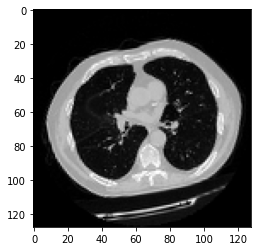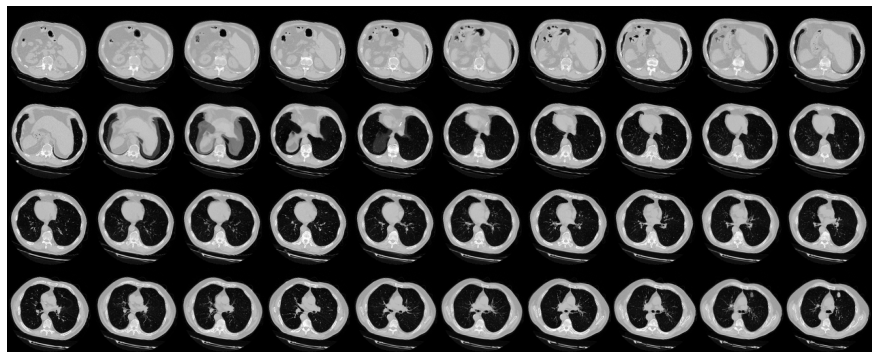Python构建3D医疗影像识别

前段时间帮别人做了一个3D分类的活,想着怎么也得整理出一篇博客给大家吧,于是乎就有了这篇文章。这篇文章讲解的项目相对早期的项目有如下改进:
1.设置的动态学习率 2.加入的早停策略 3.模型的保存时间更加“智能” 4.在数据加载这块也有明显的优化
🚀 我的环境:
语言环境:Python3.6.5 编译器:jupyter notebook 深度学习环境:TensorFlow2.4.1 显卡(GPU):NVIDIA GeForce RTX 3080 数据链接: https://pan.baidu.com/s/1_8T3PthALINkqsu7yquODw 提取码: ueka
🚀 来自专栏:《深度学习100例》
CT 扫描 3D 图像分类
创作时间:2021年8月23日下午 任务描述:训练一个 3D 卷积神经网络来预测肺炎的存在。
一、前期工作
1. 介绍
本案例将展示通过构建 3D 卷积神经网络 (CNN) 来预测计算机断层扫描 (CT) 中病毒性肺炎是否存在。2D 的 CNN 通常用于处理 RGB 图像(3 个通道)。3D 的 CNN 仅仅是 3D 等价物,我们可以将 3D 图像简单理解成 2D 图像的叠加。3D 的 CNN 可以理解成是学习立体数据的强大模型。
import os,zipfile
import numpy as np
from tensorflow import keras
from tensorflow.keras import layers
import tensorflow as tf
gpus = tf.config.list_physical_devices("GPU")
if gpus:
tf.config.experimental.set_memory_growth(gpus[0], True) #设置GPU显存用量按需使用
tf.config.set_visible_devices([gpus[0]],"GPU")
# 打印显卡信息,确认GPU可用
print(gpus)
[PhysicalDevice(name='/physical_device:GPU:0', device_type='GPU')]
2. 加载和预处理数据
数据文件是 Nifti,扩展名为 .nii。我使用nibabel 包来读取文件,你可以通过 pip install nibabel 来安装 nibabel 包。
数据预处理步骤:
首先将体积旋转 90 度,确保方向是固定的 将 HU 值缩放到 0 和 1 之间。 调整宽度、高度和深度。
我定义了几个辅助函数来完成处理数据,这些功能将在构建训练和验证数据集时使用。
import nibabel as nib
from scipy import ndimage
def read_nifti_file(filepath):
# 读取文件
scan = nib.load(filepath)
# 获取数据
scan = scan.get_fdata()
return scan
def normalize(volume):
"""归一化"""
min = -1000
max = 400
volume[volume < min] = min
volume[volume > max] = max
volume = (volume - min) / (max - min)
volume = volume.astype("float32")
return volume
def resize_volume(img):
"""修改图像大小"""
# Set the desired depth
desired_depth = 64
desired_width = 128
desired_height = 128
# Get current depth
current_depth = img.shape[-1]
current_width = img.shape[0]
current_height = img.shape[1]
# Compute depth factor
depth = current_depth / desired_depth
width = current_width / desired_width
height = current_height / desired_height
depth_factor = 1 / depth
width_factor = 1 / width
height_factor = 1 / height
# 旋转
img = ndimage.rotate(img, 90, reshape=False)
# 数据调整
img = ndimage.zoom(img, (width_factor, height_factor, depth_factor), order=1)
return img
def process_scan(path):
# 读取文件
volume = read_nifti_file(path)
# 归一化
volume = normalize(volume)
# 调整尺寸 width, height and depth
volume = resize_volume(volume)
return volume
读取CT扫描文件的路径
# “CT-0”文件夹中是正常肺组织的CT扫描
normal_scan_paths = [
os.path.join(os.getcwd(), "MosMedData/CT-0", x)
for x in os.listdir("MosMedData/CT-0")
]
# “CT-23”文件夹中是患有肺炎的人的CT扫描
abnormal_scan_paths = [
os.path.join(os.getcwd(), "MosMedData/CT-23", x)
for x in os.listdir("MosMedData/CT-23")
]
print("CT scans with normal lung tissue: " + str(len(normal_scan_paths)))
print("CT scans with abnormal lung tissue: " + str(len(abnormal_scan_paths)))
CT scans with normal lung tissue: 100
CT scans with abnormal lung tissue: 100
# 读取数据并进行预处理
abnormal_scans = np.array([process_scan(path) for path in abnormal_scan_paths])
normal_scans = np.array([process_scan(path) for path in normal_scan_paths])
# 标签数字化
abnormal_labels = np.array([1 for _ in range(len(abnormal_scans))])
normal_labels = np.array([0 for _ in range(len(normal_scans))])
二、构建训练和验证集
从类目录中读取扫描并分配标签。对扫描进行下采样以具有 128x128x64 的形状。将原始 HU 值重新调整到 0 到 1 的范围内。最后,将数据集拆分为训练和验证子集。
# 按照7:3的比例划分训练集、验证集
x_train = np.concatenate((abnormal_scans[:70], normal_scans[:70]), axis=0)
y_train = np.concatenate((abnormal_labels[:70], normal_labels[:70]), axis=0)
x_val = np.concatenate((abnormal_scans[70:], normal_scans[70:]), axis=0)
y_val = np.concatenate((abnormal_labels[70:], normal_labels[70:]), axis=0)
print(
"Number of samples in train and validation are %d and %d."
% (x_train.shape[0], x_val.shape[0])
)
Number of samples in train and validation are 140 and 60.
三、数据增强
CT扫描也通过在训练期间在随机角度旋转来增强数据。由于数据存储在Rank-3的形状(样本,高度,宽度,深度)中,因此我们在轴4处添加大小1的尺寸,以便能够对数据执行3D卷积。因此,新形状(样品,高度,宽度,深度,1)。在那里有不同类型的预处理和增强技术,这个例子显示了一些简单的开始。
import random
from scipy import ndimage
@tf.function
def rotate(volume):
"""不同程度上进行旋转"""
def scipy_rotate(volume):
# 定义一些旋转角度
angles = [-20, -10, -5, 5, 10, 20]
# 随机选择一个角度
angle = random.choice(angles)
volume = ndimage.rotate(volume, angle, reshape=False)
volume[volume < 0] = 0
volume[volume > 1] = 1
return volume
augmented_volume = tf.numpy_function(scipy_rotate, [volume], tf.float32)
return augmented_volume
def train_preprocessing(volume, label):
volume = rotate(volume)
volume = tf.expand_dims(volume, axis=3)
return volume, label
def validation_preprocessing(volume, label):
volume = tf.expand_dims(volume, axis=3)
return volume, label
在定义训练和验证数据加载器的同时,训练数据将进行不同角度的随机旋转。训练和验证数据都已重新调整为具有 0 到 1 之间的值。
# 定义数据加载器
train_loader = tf.data.Dataset.from_tensor_slices((x_train, y_train))
validation_loader = tf.data.Dataset.from_tensor_slices((x_val, y_val))
batch_size = 2
train_dataset = (
train_loader.shuffle(len(x_train))
.map(train_preprocessing)
.batch(batch_size)
.prefetch(2)
)
validation_dataset = (
validation_loader.shuffle(len(x_val))
.map(validation_preprocessing)
.batch(batch_size)
.prefetch(2)
)
四、数据可视化
import matplotlib.pyplot as plt
data = train_dataset.take(1)
images, labels = list(data)[0]
images = images.numpy()
image = images[0]
print("Dimension of the CT scan is:", image.shape)
plt.imshow(np.squeeze(image[:, :, 30]), cmap="gray")
Dimension of the CT scan is: (128, 128, 64, 1)
def plot_slices(num_rows, num_columns, width, height, data):
"""Plot a montage of 20 CT slices"""
data = np.rot90(np.array(data))
data = np.transpose(data)
data = np.reshape(data, (num_rows, num_columns, width, height))
rows_data, columns_data = data.shape[0], data.shape[1]
heights = [slc[0].shape[0] for slc in data]
widths = [slc.shape[1] for slc in data[0]]
fig_width = 12.0
fig_height = fig_width * sum(heights) / sum(widths)
f, axarr = plt.subplots(
rows_data,
columns_data,
figsize=(fig_width, fig_height),
gridspec_kw={"height_ratios": heights},
)
for i in range(rows_data):
for j in range(columns_data):
axarr[i, j].imshow(data[i][j], cmap="gray")
axarr[i, j].axis("off")
plt.subplots_adjust(wspace=0, hspace=0, left=0, right=1, bottom=0, top=1)
plt.show()
# Visualize montage of slices.
# 4 rows and 10 columns for 100 slices of the CT scan.
plot_slices(4, 10, 128, 128, image[:, :, :40])
五、构建3D卷积神经网络模型
为了使模型更容易理解,我将其构建成块。
def get_model(width=128, height=128, depth=64):
"""构建 3D 卷积神经网络模型"""
inputs = keras.Input((width, height, depth, 1))
x = layers.Conv3D(filters=64, kernel_size=3, activation="relu")(inputs)
x = layers.MaxPool3D(pool_size=2)(x)
x = layers.BatchNormalization()(x)
x = layers.Conv3D(filters=64, kernel_size=3, activation="relu")(x)
x = layers.MaxPool3D(pool_size=2)(x)
x = layers.BatchNormalization()(x)
x = layers.Conv3D(filters=128, kernel_size=3, activation="relu")(x)
x = layers.MaxPool3D(pool_size=2)(x)
x = layers.BatchNormalization()(x)
x = layers.Conv3D(filters=256, kernel_size=3, activation="relu")(x)
x = layers.MaxPool3D(pool_size=2)(x)
x = layers.BatchNormalization()(x)
x = layers.GlobalAveragePooling3D()(x)
x = layers.Dense(units=512, activation="relu")(x)
x = layers.Dropout(0.3)(x)
outputs = layers.Dense(units=1, activation="sigmoid")(x)
# 定义模型
model = keras.Model(inputs, outputs, name="3dcnn")
return model
# 构建模型
model = get_model(width=128, height=128, depth=64)
model.summary()
Model: "3dcnn"
_________________________________________________________________
Layer (type) Output Shape Param #
=================================================================
input_1 (InputLayer) [(None, 128, 128, 64, 1)] 0
_________________________________________________________________
conv3d (Conv3D) (None, 126, 126, 62, 64) 1792
_________________________________________________________________
max_pooling3d (MaxPooling3D) (None, 63, 63, 31, 64) 0
_________________________________________________________________
batch_normalization (BatchNo (None, 63, 63, 31, 64) 256
_________________________________________________________________
conv3d_1 (Conv3D) (None, 61, 61, 29, 64) 110656
_________________________________________________________________
max_pooling3d_1 (MaxPooling3 (None, 30, 30, 14, 64) 0
_________________________________________________________________
batch_normalization_1 (Batch (None, 30, 30, 14, 64) 256
_________________________________________________________________
conv3d_2 (Conv3D) (None, 28, 28, 12, 128) 221312
_________________________________________________________________
max_pooling3d_2 (MaxPooling3 (None, 14, 14, 6, 128) 0
_________________________________________________________________
batch_normalization_2 (Batch (None, 14, 14, 6, 128) 512
_________________________________________________________________
conv3d_3 (Conv3D) (None, 12, 12, 4, 256) 884992
_________________________________________________________________
max_pooling3d_3 (MaxPooling3 (None, 6, 6, 2, 256) 0
_________________________________________________________________
batch_normalization_3 (Batch (None, 6, 6, 2, 256) 1024
_________________________________________________________________
global_average_pooling3d (Gl (None, 256) 0
_________________________________________________________________
dense (Dense) (None, 512) 131584
_________________________________________________________________
dropout (Dropout) (None, 512) 0
_________________________________________________________________
dense_1 (Dense) (None, 1) 513
=================================================================
Total params: 1,352,897
Trainable params: 1,351,873
Non-trainable params: 1,024
_________________________________________________________________
六、训练模型
# 设置动态学习率
initial_learning_rate = 1e-4
lr_schedule = keras.optimizers.schedules.ExponentialDecay(
initial_learning_rate, decay_steps=30, decay_rate=0.96, staircase=True
)
# 编译
model.compile(
loss="binary_crossentropy",
optimizer=keras.optimizers.Adam(learning_rate=lr_schedule),
metrics=["acc"],
)
# 保存模型
checkpoint_cb = keras.callbacks.ModelCheckpoint(
"3d_image_classification.h5", save_best_only=True
)
# 定义早停策略
early_stopping_cb = keras.callbacks.EarlyStopping(monitor="val_acc", patience=15)
epochs = 100
model.fit(
train_dataset,
validation_data=validation_dataset,
epochs=epochs,
shuffle=True,
verbose=2,
callbacks=[checkpoint_cb, early_stopping_cb],
)
Epoch 1/100
70/70 - 18s - loss: 0.7115 - acc: 0.5143 - val_loss: 0.8686 - val_acc: 0.5000
Epoch 2/100
70/70 - 15s - loss: 0.6595 - acc: 0.6643 - val_loss: 0.8958 - val_acc: 0.5000
Epoch 3/100
70/70 - 15s - loss: 0.6623 - acc: 0.6214 - val_loss: 0.8238 - val_acc: 0.5000
Epoch 4/100
......
70/70 - 15s - loss: 0.5098 - acc: 0.7571 - val_loss: 0.5803 - val_acc: 0.6667
Epoch 43/100
70/70 - 15s - loss: 0.5083 - acc: 0.7857 - val_loss: 0.6009 - val_acc: 0.6333
Epoch 44/100
70/70 - 15s - loss: 0.5276 - acc: 0.7429 - val_loss: 0.5300 - val_acc: 0.7000
Epoch 45/100
70/70 - 15s - loss: 0.5158 - acc: 0.7500 - val_loss: 0.5504 - val_acc: 0.6833
Epoch 46/100
70/70 - 15s - loss: 0.4648 - acc: 0.8357 - val_loss: 0.5724 - val_acc: 0.6833
<tensorflow.python.keras.callbacks.History at 0x1becc8326d8>
注意:由于样本数量非常少(只有 200 个),而且我没有指定随机种子。因此,你可以预期结果可能会有显着差异。
七、可视化模型性能
fig, ax = plt.subplots(1, 2, figsize=(20, 3))
ax = ax.ravel()
for i, metric in enumerate(["acc", "loss"]):
ax[i].plot(model.history.history[metric])
ax[i].plot(model.history.history["val_" + metric])
ax[i].set_title("Model {}".format(metric))
ax[i].set_xlabel("epochs")
ax[i].set_ylabel(metric)
ax[i].legend(["train", "val"])
八、对单次 CT 扫描进行预测
# 加载模型
model.load_weights("3d_image_classification.h5")
prediction = model.predict(np.expand_dims(x_val[0], axis=0))[0]
scores = [1 - prediction[0], prediction[0]]
class_names = ["normal", "abnormal"]
for score, name in zip(scores, class_names):
print(
"This model is %.2f percent confident that CT scan is %s"
% ((100 * score), name)
)
This model is 27.88 percent confident that CT scan is normal
This model is 72.12 percent confident that CT scan is abnormal
注:本文参考了官方代码,并对里面的一些内容做了改动。



